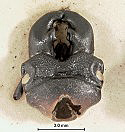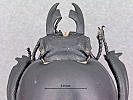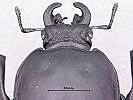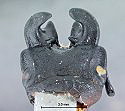Life > Eukaryotes > Opisthokonta > Metazoa (animals) > Bilateria > Ecdysozoa > Panarthropoda > Tritocerebra > Arthopoda > Mandibulata > Atelocerata > Panhexapoda > Hexapoda
> Insecta
(insects) > Dicondyla > Pterygota > Metapterygota > Neoptera > Eumetabola >
Holometabola > Coleoptera
(beetles)
> Polyphaga > Superfamily: Scarabaeoidea
> Family: Lucanidae > Subfamily:
Lucaninae
Beetles driven to great heights or left high and dry?
The
Colophon Stag beetles (Family Lucanidae) are endemic to high altitude
mountainous areas of the Western Cape in South Africa. Colophon is the genus name and there are 17 described species, each
restricted to its own mountain range or peak within a range. The Lucanidae
belong to the superfamily Scarabaeoidea which also includes other families such
as the Scarabaeidae (dung beetles, fruit chafers etc.)
Colophon
beetles are also called Barnard's stag beetles as it was Dr Keppel Barnard
(1887-1964) who did much of the pioneering research on Colophon when he
worked at the South African Museum. Barnard was a keen mountaineer and it was
this pastime that led his and Colophon's paths to cross. As a member of
the Mountain Club of South Africa, Barnard often went on his mountain
expeditions with fellow members such as K. Cameron,
A. Izard, H. Liddle, A.
Prentice, R. Primos and T. Stokoe. Although Barnard did not approve of
deriving species names from personal names, he named many Colophon
species after his mountaineering friends as he conceded that he owed so much to
them.
This genus is under threat by indiscriminate
collectors, habitat destruction and climate change and are therefore under the
protection of nature conservation laws with heavy penalties imposed for illegal
collecting.
All Colophon species are listed as endangered and
Colophon primosi
as critically endangered. See
Conservation.
The genus name, Colophon, is derived from the Greek word kolophon,
meaning summit or peak. In association with other Greek words, it has other
meanings relating to a finish or conclusion, usually to a book.
Species in southern Africa
Colophon genus is endemic to the Western
Cape province in South Africa, where 17 species have been found, each restricted to
its own mountain range or peak within a range.
|
Colophon barnardi
Leeuwrivier Mt., Swellendam Mountains,
Western Cape
|
 |
|
Colophon
berrisfordi
Meiringspoort, Swartberg Range, Western Cape
|
No image |
|
Colophon cameroni
Waaihoek, Witzenberg, Fonteinjiesberg, Hex River Mountains, Western
Cape
|
 |
|
Colophon cassoni
Meiringspoort, Swartberg Mountians, Western Cape
|
 |
|
Colophon eastmani
Keeromberg, Western Cape Mountains
|
 |
|
Colophon endroedyi
Osberg, Swartberg Range, Western Cape
|
 |
|
Colophon haughtoni
Matroosberg, Hex River Mountains, Western Cape
|
 |
|
Colophon izardi
Lemoenshoek, Grootberg, Langeberg Range, Western Cape
|
 |
|
Colophon kawaii
Matroosberg Range, Western Cape
|
 |
|
Colophon
montisatris
Blesberg, Swartberg Range, Western Cape
|
 |
|
Colophon neli
Swartberg Range, Western cape
|
 |
|
Colophon oweni
Riversdale Mountains, Western Cape
|
 |
|
Colophon primosi
Seweweekspoort, Swartberg Range, Western Cape
|
 |
|
Colophon stokoei
Hottentots Holland , Palmiet Mts, Stellenbosch Mts,
Franschhoek Mts , Berg River Range and Wellington Mountains, Western
Cape
|
 |
|
Colophon thunbergi
Zuurbraak, Langeberg Range, Western Cape
|
 |
|
Colophon westwoodi
Table Mountain Range, Western Cape
|
 |
|
Colophon whitei
Meiringspoort, Swartberg Mountains, Western Cape
|
 |
Species groups
Cladistic analysis (http://www.ucmp.berkeley.edu/clad/clad1.html)
has shown that there are two species groups or lineages. Pleisiomorphic and
Apomorphic lineage.
Apomorphic species.
Aedeagus (penis and parameres) are
distinctly asymmetrical, the right paramere is strongly dilated forming a
hook on the inner margin with the anal sternite correspondingly asymmetrical on
the posterior margin; penis well sclerotised (cuticle hardened); anterior
(front) margin of the clypeus raised above the level of the labrum at the suture
(join). Compare genitalia of species groups.
Apomorphic species include: Colophon barnardi,
Colophon berrisfordi, Colophon cassoni,
Colophon endroedyi, Colophon izardi,
Colophon montisatris, Colophon neli,
Colophon oweni, Colophon primosi,
Colophon thunbergi, Colophon westwoodi
and Colophon whitei.
Plesiomorphic species.
Plesiomorphic species include:
Colophon cameroni,
Colophon eastmani, Colophon haughtoni,
Colophon kawaii and
Colophon stokoei.
The aedeagus (penis and parameres) appears almost symmetrical although the
parameres (claspers) are slightly asymetrical (therefore the anal sternite
evenly rounded); penis feebly sclerotized (cuticle not hardened) with transverse
ribbing; clypeus meets labrum (components of the head ) on even level. Compare
genitalia of species groups.
Colophon
beetles are medium sized and body sizes range from about 14mm to 34mm, including
the mandibles (jaws) and are dark brown in colour. They are heavy bodied like
the dung beetles and also have toothed tibia (forelegs) adapted for digging.
However, unlike dung beetles that belong to the family Scarabaeidae, Colophon
belong to the related family, Lucanidae. Unlike most of the Lucanidae,
Colophon are flightless but barchypterous (bear rudimentary/vestigial wings
under the elytra or wing covers).
Flightlessness.
As with other Lucanidae and most other members of the Scarabaeoidea super
family, Colophon’s eyes are situated on the side of the flattened head and serve
both the upper and lower body equally, very much like some aquatic beetles. This
helps with all-round vision when in wet or submerged semi-wet conditions such as
in wet dung, soft fruits etc.
Females of the various species look very similar and although there are physical
differences, the females of the species cannot be as easily differentiated as
the males and it is the male morphology (body structure) which differentiates
the species. In the males, the diagnostic characters are the genitalia,
mandibles (jaws), front tibia (foreleg) and mentum (part of the mouthparts). The
male mandibles are greatly enlarged while the females’ are small and
non-diagnostic. Compare male and
female morphology. It is thought that the males use the mandibles for combat
in rivalry for females where they flip their rivals onto their backs.
Colophon
beetles are of particular interest as each of the 17 species is isolated on a
mountain range and in some cases, on a peak within the same range, separated by
deep gorges or low lying areas. Consequently, the beetles are referred to as
"mountain relics". This is because it is thought that they are surviving
representatives of a cool, moist biome that once existed at a low altitude but
which now only survives in mountain ranges at high altitudes. It is believed
that as low lying plains dried out and became uninhabitable, so the species
moved to higher altitudes. Over time, communities of the species became isolated
on mountain ranges, separated by uninhabitable open plains or gorges. This
resulted in speciation, where one or more species evolved into a series of
different, although closely related, species, each restricted to its own
mountain range, a translocated relic habitat that became their refuge or
refugium.
One species group or lineage, the Pleisiomorphic lineage, is restricted to the
Hottentots Holland, Steenbras, Hex River, Stellenbosch and Wellington Mountain
ranges.
Another species group or lineage, the Apomorphic lineage species occur in the
Table Mountain range, Swartberg, Meiringspoort, Swellendam and Heidelberg
Mountains.
What is of particular interest is the species that occurs on the Table Mountain
range. They are placed within the
Apomorphic lineage and yet it is separated from its two closest related species
that occurs further east in the Swellendam Mountains, by a group of
Pleisiomorphic species on the Hottentots Holland and Steenbrass Mountain ranges.
Beetles have also been seen in the Cedarberg Mountains and it would be
interesting to see to how this / these species is / are related to the others.
Questions regarding
Colophon species’ relationships could be explained if more was known of
the dispersion history. DNA analysis might also help clarify matters.
Furthermore, DNA analysis would not only clarify relationships of currently
known species but even establish if there are in fact as many species as
documented. There is also anecdotal evidence that males mate with females of any
species but as females of different species are difficult to differentiate, this
would have to be investigated further.
Despite their geographic separation, all species are thought to persist in
conditions that are similar to the original ancestral conditions so as
to maintain conditions conducive to existence.
Colophon
species have moved into very tight habitat niches in an effort to maintain those
conditions. This is reflected in the altitudes at which they occur. In the
Swartberg range, which is the driest habitat with the least cloud cover, the
beetles occur at about 2000 m and are absent from lower levels. In the Langeberg
Mountains they occur at lower levels, from 1300 m where conditions are optimal
and at the other end of the scale, the species in the Table Mountain range,
occurs at below 1000 m. By all accounts, Colophon beetles are active for
a very short period in summer reducing that niche further. Perhaps in the past
they were active throughout the year when conditions were ideal.
In ancient times the Karoo areas that are now arid, were once vast cool, temperate, marshy plains
north and north east of the Western Cape mountain ranges. River systems such as
the Berg, Breede, Gouritz, Olifants, Gamka and many others would have been
extensive, and in some cases probably even interlinked lakes and floodplains and
what we see of them today are mere trickles of their former splendour. Rainfall
was high with regular flooding. These areas must have been prolifically covered
with vast amounts of trees, plants and decaying material. In a habitat where
food and mates were abundant, flight was either not a priority or an option if
predators prevailed. Flightlessness.
With climate change and the associated aridification and increase in
temperatures, rivers and moisture would have receded taking with them associated
plants and animals. Some plants and associated animals would have receded
downward with the moisture and some would have clung to corridors of moist and
shaded gorges that might have provided access to moister, cooler climes above.
Eventually, with complete aridification, all species that migrated downward and
could not adapt, would have been doomed and those that clung to favoured
habitats at higher altitudes, survived.
Perhaps conditions became too wet before
they became too dry, resulting in the migrations upwards. Perhaps there was an
extended event of massive flooding in which case everything would have been
washed away and the flotsam of plants and animals deposited on higher ground.
Mountains of plant debris would have been deposited and had the water persisted
long enough, the verdant floodplains would have been destroyed as happens with
present day dams. There would be no going back but instead to eke out a living
on debris and new growth that was available on the raised foothills where
species were deposited. Climate change and aridification at that stage would
also have meant no going back downhill.
For animals that could not fly or move freely, competition among different
species for food and mates in a reduced habitat would have been fierce and only
those with distinct physical advantages would have survived to breed. Isolated
from the original homogenous population by vast tracts of inhospitable lowlands
- or water - animals and insects with restricted movement would have followed
the food source and if that moved up the slopes to cooler, moister climes, so
would they.
Colophon is considered to be a link to
Gondwanaland but according to specialists, there is no evolutionary link between
Colophon and old-world African Lucanidae. Not only does Colophon not
seem to have derived from them but neither does the old-world Africa stock seem
to have been derived from Colophon. Furthermore, it is also difficult to
establish Colophon's relationship with other members of the Lucanidae
family. Specialists agree that Colophon
does not belong to either of the southern hemisphere subfamilies but is better
placed with the Lucaninae. This is a bit of a mystery especially when
specialists seem to conclude that all our primordial fauna are southern in
origin.
Barnard (1929) also studied other high-mountain fauna and suggested that all
high mountain flora and fauna originate from a distinct biome. One such animal
is the fresh-water Crustacean, Phreatoicus
which is also restricted to high altitudes. However, Barnard was puzzled
by the fact that
Colophon occurs as different species in the various localities while Phreatoicus remains unchanged. It is interesting to speculate that
this would be expected had extended flooding been a factor that isolated Colophon
because Phreatoicus
would not have been isolated. However, Barnard (1929) concedes the need for the
intervention of the geologist to establish the age of the rock formations of the
gorges that separate species and this would help to establish the age of
Colophon.
Whatever the event that caused the speciation, survival resulted from a balance
between the magnitude of the environmental differences before and after the
event and the adaptive capacity of the surviving populations. The genetic makeup
that determined the adaptive characters of survival became fixed in the
‘shipwrecked’ survivors and perpetuated in subsequent generations.
Colophon beetles are reported to be rarely
seen and very little is known of their life histories. Most sightings take place
from November to January. It is generally believed that it is a few privileged
mountain climbers who are lucky enough to see them and then they might only see
them if enough time is spent in the mountains. Conditions also need to be ideal
and these can only be described as less than ideal for the average recreational
mountaineer. It has also been documented that Colophon's
activities are restricted to early mornings and late afternoons, even after
sunset, in cool misty, foggy and even rainy conditions. However, while there is
agreement regarding the months of activity, there are contradictions regarding
conditions under which they are active. They are definitely diurnal and not
nocturnal as Barnard initially thought. They have been sighted at any time of
day, even in midday heat and in some cases in large numbers to the extent where
"hikers trample them on paths".
Larvae of the Lucanidae are generally internal wood and decaying wood feeders so
the family is essentially associated with forests. However, this is not the case
with Colophon as there have been no
trees or woody shrubs in any of the areas where live specimens have been
collected. The larvae are probably not borers at all and might feed on roots
instead. Barnard noted that all specimens that he found were in Erica-Restio
habitats and he fancied the Restionaceae option. However, some studies were done
(Scholtz & Endrödy-Younga, 1994) on a few larvae under laboratory conditions
where they were observed to feed on humus-rich soil that was sampled with the
animals.
Barnard’s observations are confirmed by reports that beetles are reported to
occur on slopes near drainage areas where restios occur, so beetles probably
feed on root debris and detritus nutrients in the soil. They have also been
found under rocks. It would seem that eggs are laid in the soil and the larvae
remain there for three to four years. Not too much is known about the larvae as
they are difficult to find and only the larva of one species has been described.
Larvae have been bred out under laboratory conditions by being placed under a
stone with damp soil and dung and kept cool and damp. The adult emerged after 2
years.
One wonders if their food source is still what it was in their original
ancestral habitats or were they also borers of wood and have merely adapted to
something else as conditions changed. Scholtz, Harrison and Grebennikov (2004)
cite
Pachysoma (all species) as an example of such a change where they abandoned
dung-rolling habits in wet habitat and reverted to what is thought to have been
ancestral habits of collecting and assembling dry dung as conditions dried out.
This is deposited in pre-excavated burrows where eggs are laid and larvae move
freely in tunnels.
Some present day Scarabaeidae beetles are also known to have changed
their habits due to pressure or choice and have adapted to modern conditions
such as from herbivore dung to domestic dog faeces (Onthophagus
ebenus) and there’s an anecdotal record where there was a shift from dung to
golf course grass (Bolbocaffer peringueyi).
Fossil records of 5 million years ago from the
West Coast Fossil Park and Karoo areas indicate moist riverine habitats with
trees and palm trees (as well as bears and sabre-toothed cats). Being feeders of
rotting vegetation probably pre-adapted them to survive and rotting fibre plants
such as palms and restios were/are similar enough for a desperate Colophon.
As far back as 1929, Dr Barnard cited veld fires as a threat to Colophon
and that threat is now more alarming. Since then human encroachment results in
all too frequent fires that rage in the hot summer months. However,
Colophon has survived thus far even with the added threat of climate change.
Being soil dwelling insects, they have probably evolved ways of avoiding fire.
While they might have evolved ways of surviving
intermittent fires, they are
neither equipped to survive the greed of humans who collect every available
adult for personal enrichment nor the modern conveniences of humans such as 4X4
vehicles and concrete platforms for cell phone masts. Furthermore, the effect of
the radiation from
repeater masts might also have a negative impact.
Being flightless precludes Colophon beetles from readily escaping fire
and and collectors as other insects do. Neither can they seek out and colonise
better habitats when theirs becomes too degraded for survival. This, and the
fact that so little is known of their biology, places their long-term survival
at great risk. It is not known what comprises an ideal
Colophon habitat. It is not known how many eggs are laid by a single adult.
It is not known what proportion of adults emerge during ideal times. If the
emergence of an entire adult population coincides with a visit by collectors, an
entire adult breeding population could be destroyed especially if collection
precedes egg laying. It is also not known how long the eggs take to emerge or how
long the larvae remain underground although it is thought to be 3 to 4 years. It
is not known if
Colophon might be similar to some scarabs where the presence of the female
is needed for the emergence of the brood although this notion is dispelled by
the success under laboratory conditions described above.
As a result of commercial pressure, Colophon beetles have been placed on CITES Schedule II (CITES,
Convention on International Trade in Endangered Species - in wild flora and
fauna, http://www.cites.org). This means that no trade, exchange or sale of Colophon
species is allowed. Limited reference specimens may only be collected for
scientific purposes with the appropriate permit issued by the Department of
Western Cape Nature Conservation.
All Colophon species are listed as endangered and
Colophon primosi
as critically endangered.
Local governments have increased pressure on poachers. In January 2004, a group
of German collectors was arrested near Ceres and a few hundred beetle specimens
of about 16 beetle species were confiscated and these include
Colophon. They were arrested,
prosecuted and fined R125 000.00.
At present, the main threat to this genus is over-collecting by European and
Japanese traders.
Members of the public are requested to be vigilant regarding exploitation of,
not only threatened Colophon
species, but all species associated with the sensitive Cape Floral Biome system.
Cape Nature conservation can be contacted with queries or to report any
contraventions.
-
BARNARD, K. H. 1929. A study of the genus
Colophon
Gray. Transactions of the Royal Society of South Africa 18: 163 –182.
-
BARNARD, K. H. 1932a. The Colophon. Journal of the Mountain Club of
South Africa 34: 19-22.
-
BARNARD, K. H. 1932b. The rediscovery of Colophon thunbergi Westw.
with descriptions of further species of the genus. Stylops
1: 169-174.
-
BARTOLOZZI. L. & WERNER. K. 2004. Illustrated catalogue of the Lucanidae
from Africa and Madagascar. Taita Publishers, Czech Republic. Pages
– 189.
-
BARTOLOZZI, L. 2005. Description of two new stag beetle species from South
Africa (Coleoptera: Lucanidae). African Entomology 13(2): 347 – 352.
-
ENDRÖDY-YOUNGA, S. 1988. Evidence for the low-altitude origin of the Cape
Mountain Biome derived from the systematic revision of the genus
Colophon
Gray (Coleoptera, Lucanidae). Annals of the South African Museum 96(9) 359 –
424.
-
GRAY. G. R. 1832. New species of insects of all orders. In: Griffith, E. The
animal kingdom arranged in conformity with its organization by the Baron
Cuvier 14. London: Whittaker.
-
MIZUKAMI, T. 1996. A new species and a new subspecies of the Genus
Colophon from the Republic of South Africa (Coleoptera,
Lucanidae). Gekkan-Mushi 304: 22-25..
-
SCHOLTZ, C. H. 2000. Evolution of flighlessness in Scaraboidea,
(Coleoptera). Deutsche Entomolgische Zeitschrift. 47(1): 5 – 28.
-
SCHOLTZ, C. H. & ENDRÖDY-YOUNGA, S. 1994. Systematic position of
Colophon Gray (Coleoptera: Lucanidae), based on larval characters.
African Entomology, 2(1): 13 - 20.
-
SCHOLTZ, C. H., HARRISON, J. du G. & GREBENNIKOV, V. V.
2004 Dung beetle (Scarabaeus (Pachysoma)) biology and immature stages:
reversal to ancestral states under desert conditions (Coleoptera:
Scarabaeidae)? Biological Journal of the Linnean Society (83) 453 – 460.
-
WESTWOOD, J. O. 1855. Descriptions of some
new species of exotic Lucanidae. Transactions of the Entomological Society
of London 3: 197-221.
Images and text by Margie Cochrane
